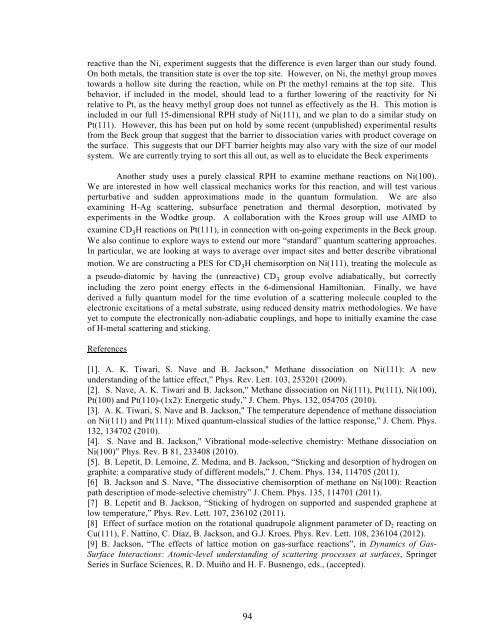Eighth Condensed Phase and Interfacial Molecular Science (CPIMS)
Eighth Condensed Phase and Interfacial Molecular Science (CPIMS)
Eighth Condensed Phase and Interfacial Molecular Science (CPIMS)
You also want an ePaper? Increase the reach of your titles
YUMPU automatically turns print PDFs into web optimized ePapers that Google loves.
eactive than the Ni, experiment suggests that the difference is even larger than our study found.<br />
On both metals, the transition state is over the top site. However, on Ni, the methyl group moves<br />
towards a hollow site during the reaction, while on Pt the methyl remains at the top site. This<br />
behavior, if included in the model, should lead to a further lowering of the reactivity for Ni<br />
relative to Pt, as the heavy methyl group does not tunnel as effectively as the H. This motion is<br />
included in our full 15-dimensional RPH study of Ni(111), <strong>and</strong> we plan to do a similar study on<br />
Pt(111). However, this has been put on hold by some recent (unpublished) experimental results<br />
from the Beck group that suggest that the barrier to dissociation varies with product coverage on<br />
the surface. This suggests that our DFT barrier heights may also vary with the size of our model<br />
system. We are currently trying to sort this all out, as well as to elucidate the Beck experiments<br />
Another study uses a purely classical RPH to examine methane reactions on Ni(100).<br />
We are interested in how well classical mechanics works for this reaction, <strong>and</strong> will test various<br />
perturbative <strong>and</strong> sudden approximations made in the quantum formulation. We are also<br />
examining H-Ag scattering, subsurface penetration <strong>and</strong> thermal desorption, motivated by<br />
experiments in the Wodtke group. A collaboration with the Kroes group will use AIMD to<br />
examine CD3H reactions on Pt(111), in connection with on-going experiments in the Beck group.<br />
We also continue to explore ways to extend our more “st<strong>and</strong>ard” quantum scattering approaches.<br />
In particular, we are looking at ways to average over impact sites <strong>and</strong> better describe vibrational<br />
motion. We are constructing a PES for CD3H chemisorption on Ni(111), treating the molecule as<br />
a pseudo-diatomic by having the (unreactive) CD3 group evolve adiabatically, but correctly<br />
including the zero point energy effects in the 6-dimensional Hamiltonian. Finally, we have<br />
derived a fully quantum model for the time evolution of a scattering molecule coupled to the<br />
electronic excitations of a metal substrate, using reduced density matrix methodologies. We have<br />
yet to compute the electronically non-adiabatic couplings, <strong>and</strong> hope to initially examine the case<br />
of H-metal scattering <strong>and</strong> sticking.<br />
References<br />
[1]. A. K. Tiwari, S. Nave <strong>and</strong> B. Jackson," Methane dissociation on Ni(111): A new<br />
underst<strong>and</strong>ing of the lattice effect,” Phys. Rev. Lett. 103, 253201 (2009).<br />
[2]. S. Nave, A. K. Tiwari <strong>and</strong> B. Jackson," Methane dissociation on Ni(111), Pt(111), Ni(100),<br />
Pt(100) <strong>and</strong> Pt(110)-(1x2): Energetic study,” J. Chem. Phys. 132, 054705 (2010).<br />
[3]. A. K. Tiwari, S. Nave <strong>and</strong> B. Jackson," The temperature dependence of methane dissociation<br />
on Ni(111) <strong>and</strong> Pt(111): Mixed quantum-classical studies of the lattice response,” J. Chem. Phys.<br />
132, 134702 (2010).<br />
[4]. S. Nave <strong>and</strong> B. Jackson," Vibrational mode-selective chemistry: Methane dissociation on<br />
Ni(100)” Phys. Rev. B 81, 233408 (2010).<br />
[5]. B. Lepetit, D. Lemoine, Z. Medina, <strong>and</strong> B. Jackson, “Sticking <strong>and</strong> desorption of hydrogen on<br />
graphite: a comparative study of different models,” J. Chem. Phys. 134, 114705 (2011).<br />
[6] B. Jackson <strong>and</strong> S. Nave, "The dissociative chemisorption of methane on Ni(100): Reaction<br />
path description of mode-selective chemistry” J. Chem. Phys. 135, 114701 (2011).<br />
[7] B. Lepetit <strong>and</strong> B. Jackson, “Sticking of hydrogen on supported <strong>and</strong> suspended graphene at<br />
low temperature,” Phys. Rev. Lett. 107, 236102 (2011).<br />
[8] Effect of surface motion on the rotational quadrupole alignment parameter of D 2 reacting on<br />
Cu(111), F. Nattino, C. Díaz, B. Jackson, <strong>and</strong> G.J. Kroes, Phys. Rev. Lett. 108, 236104 (2012).<br />
[9] B. Jackson, “The effects of lattice motion on gas-surface reactions”, in Dynamics of Gas-<br />
Surface Interactions: Atomic-level underst<strong>and</strong>ing of scattering processes at surfaces, Springer<br />
Series in Surface <strong>Science</strong>s, R. D. Muiño <strong>and</strong> H. F. Busnengo, eds., (accepted).<br />
94
















